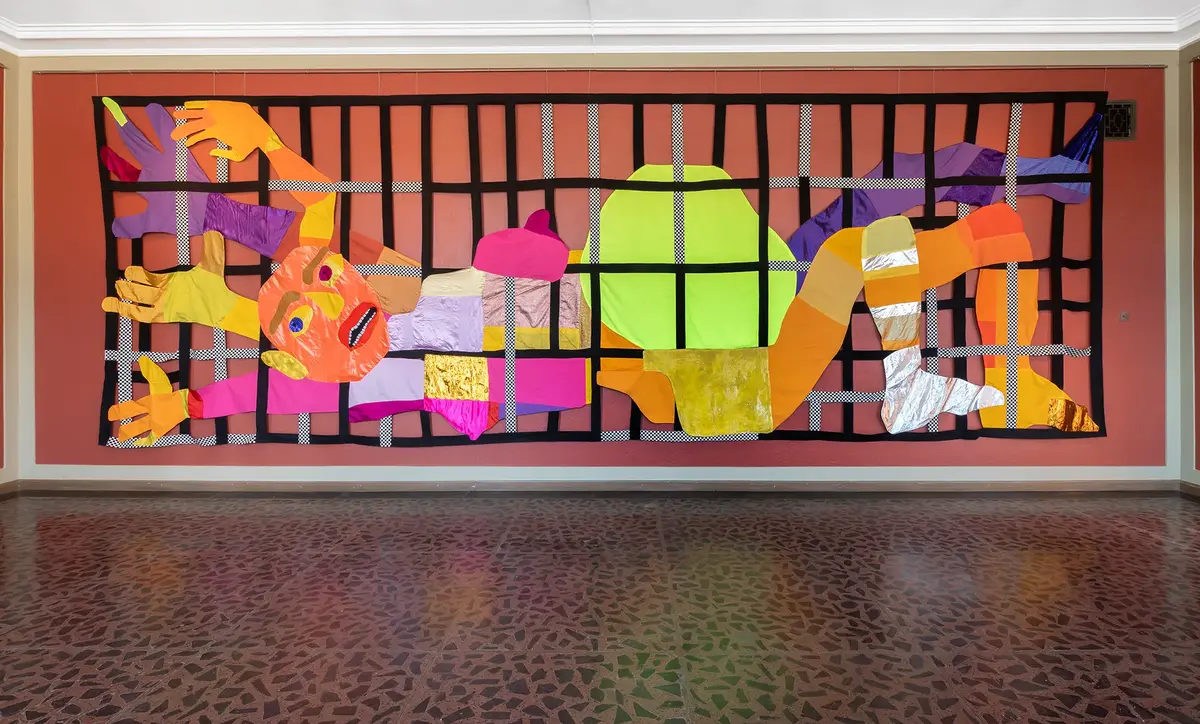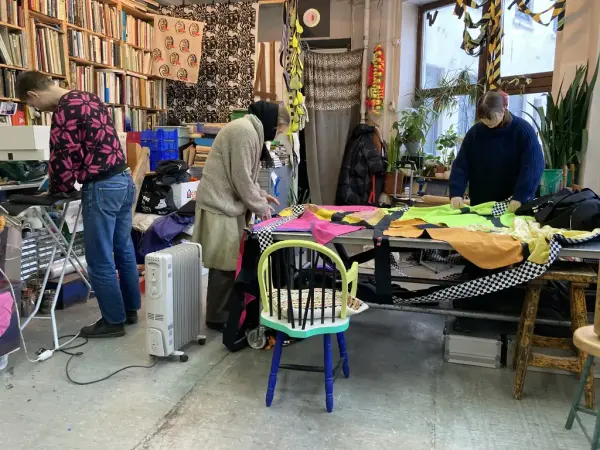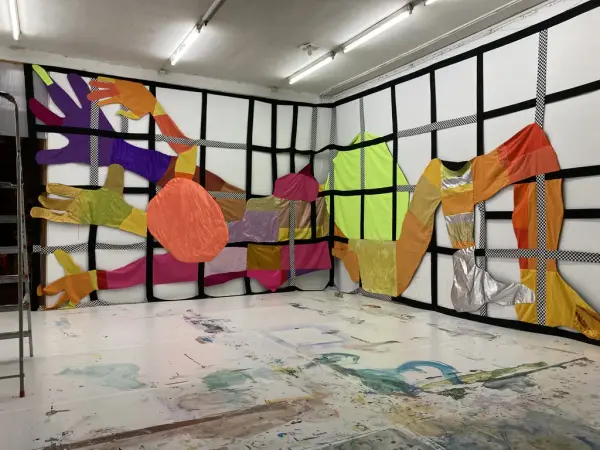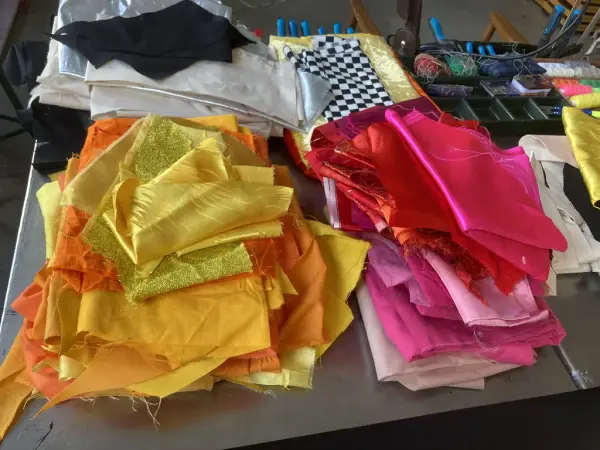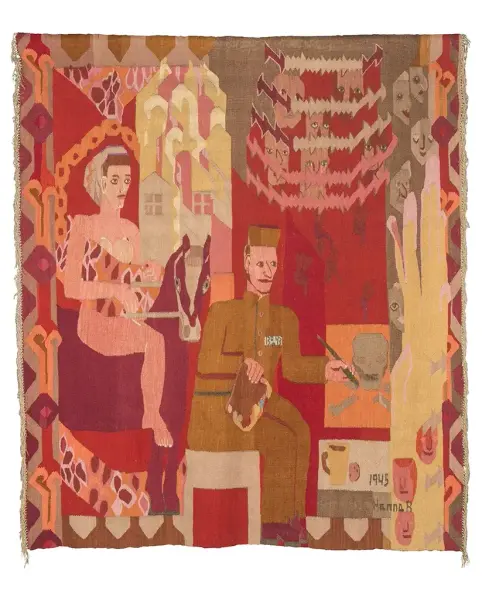Fødselen (The Birth), 2023
appliquéd textile
9x3 m
“Death has been thematized so much in art, but not birth,” [1] says the artist Elise Storsveen about her work Fødselen (The Birth), which is rooted in her own bodily experience of childbirth. Yet it is not the actual moment of birth we see, but rather the contractions — a visceral, consuming force — that have defined the experience for her. As the artist’s own labour ended in an emergency caesarean section, the contractions became her most intense and defining memory of childbirth, an experience of her body slipping entirely out of her control.
A female figure, face expressing strong feelings, lies on her back. The work is structured within a rigid grid that encloses the woman’s body, at once a cage and a measuring device. Its fragmented character echoes the geometric experimentation of Anni Albers and Gunta Stölzl, two Bauhaus textile artists who explored grid-based designs as a modernist framework, demonstrating precise mathematical structures. Their textiles highlight a tactile, visceral dimension of making, subtly challenging the rigid, masculine-coded ideas of industrial modernism. Fødselen subverts the rigidity of the grid by highlighting the body’s refusal to be fully contained or disciplined.
In Fødselen, the female body resists such ordering and invites us to trust the process at first encounter. It does not conform: it strains, ruptures, and expands beyond the limits imposed upon it. The birthing body emerges as something ungovernable, a body that invites a feminist take on abstraction that is usually usurped by modernism. The work challenges the historical erasure of birth in art and architecture, where most of the spaces that we as a society inhabit are built for bodies that are static, male, able-bodied, and adult.
The nine-meter-long tapestry subversively enables a formal dialogue with monumental art traditions, illuminating the ambiguous nature of childbirth through its application/technique. The hidden subtitle of the work, appearing on the reverse side of the tapestry, honors the importance of collectivity and collaboration required by reproductive labor of all kinds, whether it be a work of art or a human life.
Thank you Svein for making the child, thank you Marlon for being born, thank you Tuppen for the materials, thank you Ella Emma Hallvard for the seams.
- Marianne Zamecznik
[1] Konfronterer publikum med fødsler og hetetokter (Confronts the audience with births and hot flashes), by Silje Aanes Fagerlund in Altså, published 21. March 2023. https://xn--alts-toa.no/2023/03/21/rier-og-hetetokter-pa-vigelandmuseet/
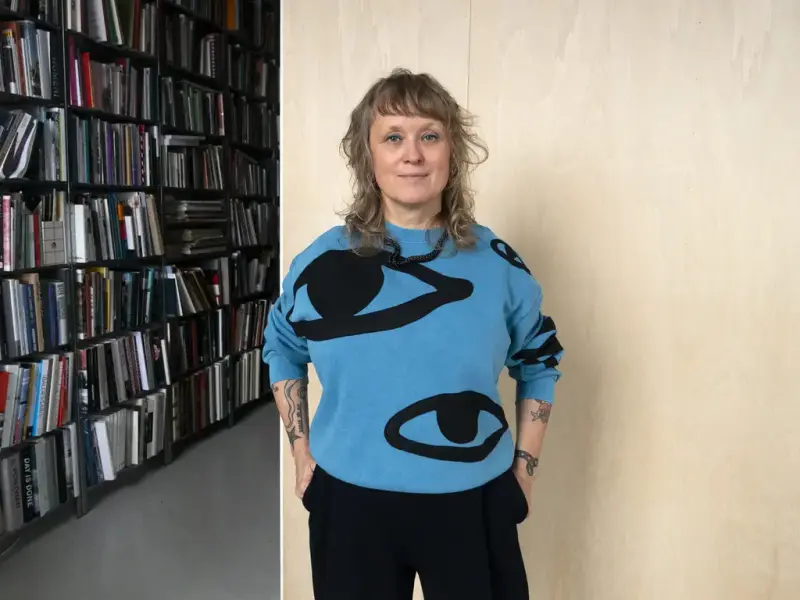
Photo: Eline Mugaas
Elise Storsveen (b.1969, Oslo) is an artist and, periodically, a curator. She works mainly with collage, as a method, and often employs pre-used textiles as material. Her works frequently focus on the human body and on social roles and collaborations. Works take the form of installations, singular objects and printed fanzines. She studied at Statens håndverk- og kunstindustriskole and Statens Kunstakademi, both in Oslo. Recent exhibitions include: G, Bryne Meieri/Bryne Kunstforening, 2024; Hetebølgene, Vigelandmuseet, Oslo, 2023; The Work That Textile Does, Museum of Textiles, Lódź, Poland, 2023; Et sted mellom 2D og 3D, Kunstnerforbundet, Oslo, 2021; Exit, Munchmuseet, Oslo, 2019; and Abstraksjon og innlevelse, Galleri Soft, Oslo, 2019. Storsveen lives and works in Oslo.
Production credits
Elise Storsveen, Fødselen (The Birth), appliquéd textile, 900x300 cm, 2023
Sewn by the artist with the additional help of Ella Aandal, Marlon Ulven, Emma Elise Ødegård Olsen og Hallvard Hovland.
The work was made for the exhibition Hetebølgene (Heatwaves) at Vigeland museum in Oslo, 2023.
